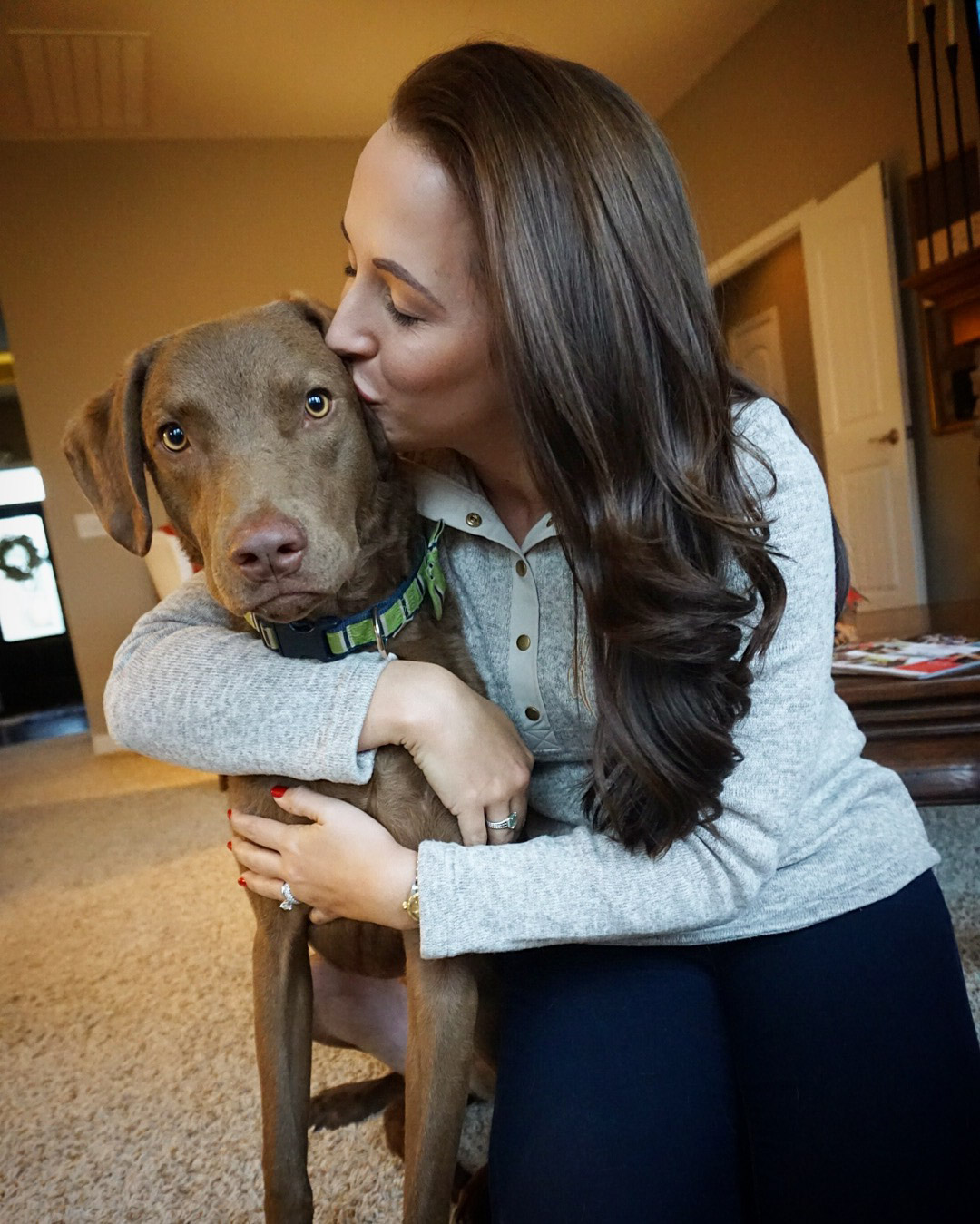
One of the biggest stressors when we relocated to the United Kingdom was figuring out how to move our pets. Grace and Tucker are our two rescue dogs and are basically our children, so there was no chance we could ever leave them behind, and we were diligent in doing our research into how to move both dogs to England.
Hopefully our experience can help give you a better idea of the process of moving your pet and what to anticipate before your move.
Contact Your Vet
If you’re considering moving your pet internationally, I would suggest contacting your vet first to notify them of the move. They will be instrumental in forwarding the correct paperwork to the appropriate places, and if they are a USDA vet, they will be the ones conducting the exams before the flight.
We were lucky that our existing vet was extremely familiar with the process of transporting pets internationally. After speaking with our vet, we felt much more comfortable in their ability to help us through this process as well.
Find a USDA-Approved Vet
If your pet’s vet isn’t USDA-certified, you will need to contact one for the final two vet appointments before the move. This vet will sign off the paperwork to send with your pet overseas. Again, our vet was USDA-certified, so this was a step we didn’t have to worry about.

Find a Pet Relocation Specialist
This is an optional step, but one I found helped me sleep at night and relieved a lot of stress. Pet relocation specialists are in the business of moving pets. It was an ease to the both of us that someone who did this as a profession and had years of experience could walk us through the process.
Martin and I were recommended a company called Animal Land Pet Movers. They frequently move animals internationally, are USDA-licensed, and were extremely helpful in the process. We worked with two people at that company to help us schedule all of our flights, purchase the appropriate crates, and ensuring we had the correct paperwork all before actually transporting the pups.
You can absolutely move your pet without a relocation specialist, and it will be cheaper. But I personally couldn’t stand the risk of having our pets in quarantine if we did the wrong paperwork, so we went ahead and worked with the pros.
Book a Flight
We lived just 20 minutes from the Indianapolis Airport but opted to fly out of Chicago so we wouldn’t need to have a connecting flight. Our chosen route was Chicago O’Hare to London Heathrow, based on both our and Animal Land’s previous experience flying pets to and from both airports. Because they were major hubs that transported pets every day, we were very comfortable flying them this route.
As you’re looking for a route, do your homework to see what the best route is for you and your pet. And remember, be sure you book the spots for your pet to fly, too. Animal Land completed this step for us, but ensured the dogs were on the same flight that we were on.
Vaccinate Your Pet
The requirements to move our dogs to England is that they were both microchipped (with proof) and were vaccinated against rabies no less than 21 days before the flight (with proof).
Our dogs were updated on all of this, so all we had to do was sort out proof. Both dogs were microchipped at their respective rescue shelters, so we were able to collect the adoption records from the shelters with the microchip numbers for each dog. Our vet was able to provide us with an official certificate of the rabies vaccinations.
Schedule Your Two Final Vet Visits
Less than ten days before the transport, each pet needs two vet visits to complete the final paperwork. Schedule those well ahead of time to ensure you can get appointments.
Purchase a Travel Kennel
We were provided with instructions from our airline, British Airways, for how to measure the dogs for air travel. BA ensures that each animal has the appropriate size cage meeting IATA kennel quality standards. Check with your airline for specifics and allow for a little larger kennel, as most airlines reserve the right to not fly your animal if it is in too small a crate. Be sure to purchase a crate for each pet, as they will need to travel separately.
Get Your Dog Acquainted With The Crate
It is really important that your animal thinks of the crate as its home so that the crate is not a source of anxiety. We started slow with both dogs, putting favourite blankets, toys, and treats inside and letting them investigate. After a bit, we’d throw a treat in the back and praise them when they would go inside, then gradually increase the demand before the reward. Within a couple days, Tucker was comfortable sleeping in his crate and Grace would lie down in it willingly.
Before the flight, we also put in a piece of each of our clothing that we had slept with so that both dogs could have our familiar smell in the crate.

Attend the Vet Appointments and Submit the Paperwork
During the initial vet appointment, the vet scanned the microchip in each dog and filled out USDA paperwork confirming rabies vaccination, general health, and the microchip number. Following the appointment, we overnighted the paperwork to a USDA office in Kentucky who filed the paperwork, signed off a document, and sent it back. This paperwork was then eventually handed off to the driver who took Grace and Tucker to the airport and must fly with the pet.
Pack a Small Bag of Dog Food in Your Checked Bags
We weren’t sure if the UK would carry the brand of dog food we fed the dogs (they didn’t), so we packed a small bag of dog food that would feed the two dogs for a week so that we could ease them into a new dog food brand. I think it’s also worth just having that safety net of food for them so you don’t have to think about finding new dog food for a few days upon landing.

Pack Your Carry On
Be sure you have everything your pet will need upon landing. I packed a leash and harness, treats, toys, prescription meds, and all paperwork we submitted along with their medical records. I also think it’s a good idea to have a photo of your pets printed and your vet’s phone number, just in case.
Get Ready to Fly!
The morning of the flight, we fed and walked the dogs so they could relieve themselves before they were picked up to fly. A representative from Animal Land Pet Movers came to the house to pick up both dogs, their crates, and the paperwork. We let the dogs smell him and become acquainted before we loaded their crates into the van. Then they were off!
Dana from Animal Land Pet Movers was a saint and emailed us when each part of the journey was accomplished – when they got to Chicago, when they were checked in, when they were loaded on the plane, etc. It definitely eased my anxiety to know they were being looked after.
I did mention at the British Airways check-in desk that we had animals that were flying on the plane, and they were surprisingly and reassuringly calm about it, telling me they fly with pets all the time. That definitely gave me a sigh of relief.

Ensure You Have A Large Vehicle to Transport to New Location
Ensure when you reach the your destination that you have a vehicle large enough for the dogs, crates, luggage, and yourselves. We ended up with three vehicles – one for the crates and our luggage, one for two humans and a dog, and one for two other humans and the other dog. It was a proper caravan!
Pick Up Your Pet at Animal Quarantine
After we landed and collected our baggage, we headed to the Heathrow Animal Reception Centre where we were to pick up the dogs. I brought copies of all the paperwork with me, and checked in upon arrival. It was another two and a half hours before the dogs were cleared to be released, so there’s no need to rush to the center. Grab a book, a snack, and your charger before you get inside.
Grace flew like a champ. She came into reception and was quite the social butterfly as she gave kisses first to me, then Martin and both Martin’s parents. She seemed to adjust very well. Tucker, given his history of trauma, didn’t fly well. He was pretty startled when he came to us, I’m sure from the unfamiliarity of it all. It took him a while to realize who we were and only started to relax when I picked up all 75 pounds of him and held him close. Within a few minutes with us, he grew more comfortable and settled.
The best thing that helped him adjust was when he ate most of a bacon sandwich from the services. Immediately he snapped out of his state and wagged his tail. There’s not much bacon won’t fix!

FAQs
Did you sedate the dogs?
No, its discouraged to sedate the dogs because it can cause disorientation and they can struggle with adjusting their body temperature. It’s much safer to keep the dogs drug free.
How much did it cost to fly the dogs?
I will just say it wasn’t cheap. It cost us about as much for their plane tickets as it did for ours. But I would give my right kidney (and maybe my left) for those pups, so cost wasn’t an issue. I would call your pet movers for a quote because the price also differs depending on departure and arrival location and size of pet.
Would you recommend flying your pet if you move?
If you are moving, then hands down YES. But if it’s for a vacation, it completely depends on the pet. I wouldn’t ever fly Tucker again just for the fun of it. But if we had to move again, I would do anything to ensure he and Grace could remain in our care. The health of the dogs is our first priority, and I believe a dog is for life.
Were your pets quarantined?
Technically, yes. They were in quarantine for only a couple hours as their paperwork was processed. As long as your pet is properly vaccinated, England currently doesn’t have a vaccination period for dogs. Please check with your vet to see if there is a lengthy quarantine for any country you’re considering traveling to.
Did I miss anything? Have other questions, or have flown with your pet before? Let me know your thoughts!
Disclaimer: This blog post is intended to be a recollection of a personal experience and does not substitute for any legal or professional advice for your own personal situation.




